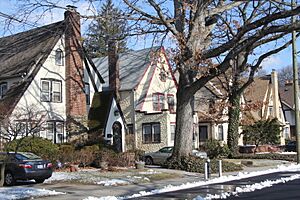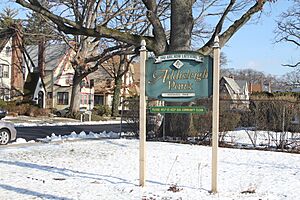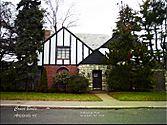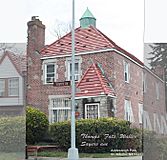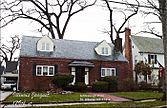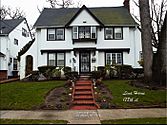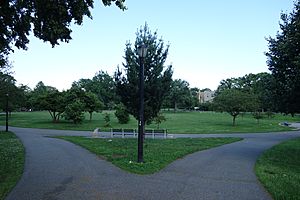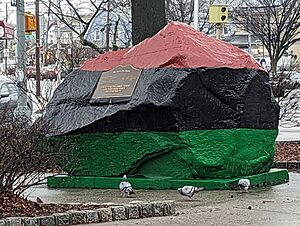St. Albans, Queens facts for kids
Quick facts for kids
St. Albans
|
|
|---|---|
|
Neighborhood of Queens
|
|
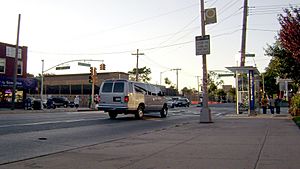
Merrick Boulevard in St. Albans, 2007
|
|
| Country | |
| State | |
| City | New York City |
| County/Borough | Queens |
| Community District | Queens 12 |
| Named for | St Albans, Hertfordshire, England |
| Population
(2010)
|
|
| • Total | 48,593 |
| Ethnicity | |
| • Black | 88.6% |
| • Hispanic | 6.5 |
| • Two or more | 2.2 |
| • White | 1.0 |
| • Other | 1.7 |
| Economics | |
| Time zone | UTC−5 (EST) |
| • Summer (DST) | UTC−4 (EDT) |
| ZIP Code |
11412
|
| Area codes | 718, 347, 929, and 917 |
St. Albans is a neighborhood in the southeastern part of Queens, a borough of New York City. It is mainly a place where people live in homes. St. Albans is surrounded by other neighborhoods like Jamaica to the northwest and Queens Village to the northeast. It is about two miles north of John F. Kennedy International Airport.
A special part of St. Albans is called Addisleigh Park. This area is a historic district. Many famous African Americans have lived here. These include sports stars like Jackie Robinson and music legends like Ella Fitzgerald.
St. Albans is part of Queens Community District 12. Its ZIP Code is 11412. The New York City Police Department's 113th Precinct keeps the area safe.
Contents
History of St. Albans
Early Beginnings
The land that is now St. Albans was given to Dutch settlers in 1655. For about 200 years, it was mostly farms and forests.
By the 1800s, four families owned most of the land. These families were the Remsens, Everitts, Ludlums, and Hendricksons. In 1814, the nearby Village of Jamaica grew to include parts of what is now St. Albans. In 1852, a pond in the area became part of the water supply for Brooklyn. This pond is now in Baisley Pond Park.
Growing into a Community
In 1872, a railroad track was built through the area. By 1892, a part of the land called Francis Farm was planned for houses. The first street lights were put up where Linden Boulevard and Farmers Boulevard meet today.
On July 1, 1898, the St. Albans Long Island Rail Road station opened. In 1899, Queens became part of New York City. The new post office for the 600 residents was named St. Albans. This name came from a town in England called St Albans. That English town was named after Saint Alban, who was an early Christian martyr. The name St. Albans was already used for the local school district since 1894.
The area was once home to the St. Albans Golf Course and Country Club. This club opened in 1915 and attracted famous golfers like Babe Ruth. The Great Depression caused the golf course to close. In 1942, the government took over the land. They built the St. Albans Naval Hospital, which opened in 1943. This hospital was very large, with 3000 beds. In 1974, it became a hospital for veterans. Part of the hospital land later became Roy Wilkins Park in the 1980s.
Addisleigh Park: A Special Place
Addisleigh Park is a small, historic part of St. Albans. It has single-family homes built between the 1910s and 1930s. At first, it was meant only for white families. However, starting in the late 1930s, many famous African Americans moved there. Today, it is still mostly an African American and Jamaican neighborhood. It is known for being a bit more upscale than other areas nearby.
In the early 1900s, developers tried to stop Black families from buying homes in Addisleigh Park. There were even lawsuits to prevent sales to Black residents. However, in 1948, the United States Supreme Court made a ruling. It said that rules preventing people from buying homes based on race were against the law. By then, Addisleigh Park was already a popular place for famous African American jazz musicians and sports stars. In 2011, the New York City Landmarks Preservation Commission declared it a historic district.
People and Community
In 2010, about 48,593 people lived in St. Albans. Most residents are African American (88.6%). About 6.5% are Hispanic.
The average life expectancy in this area is about 80.5 years. This is close to the average for all of New York City. Most people living here are young or middle-aged adults.
Homes in St. Albans are mostly detached, meaning they are not connected to other houses. They are usually one or two-family homes. Linden Boulevard is the main street for shopping.
Safety and Services
Fire Safety
The New York City Fire Department (FDNY) has two fire stations that serve St. Albans. These are Engine Company 275/Ladder Company 133 and Engine Company 317/Ladder Company 165/Battalion 54.
Post Offices
St. Albans uses the ZIP Code 11412. The United States Post Office has two branches nearby. These are the Saint Albans Station and the Rochdale Village Station.
Parks and Fun
The New York City Department of Parks and Recreation manages several public parks in St. Albans.
- St. Albans Park has places for cricket, handball, and tennis. It also has fitness equipment, a playground, and spray showers. The city got this land for a park in 1914.
- Roy Wilkins Park is a large park named after civil rights activist Roy Wilkins. It has fields for baseball, basketball, and cricket. There are also swimming pools, tennis courts, and a recreation center. This land used to be a naval hospital.
- Railroad Park is a nature area next to the Long Island Rail Road tracks.
- Daniel M. O'Connell Playground has basketball and handball courts. It also has fitness equipment and a play area. This playground is named after a World War I veteran.
Liberty Rock is a large rock in Liberty Triangle park. It is at the corner of Farmers Blvd. and Liberty Ave.
The Liberty Rock is an important symbol for the African American community in St. Albans. It is painted in red, black, and green. These are the colors of the Pan-African flag. They show the community's dedication to civil rights and unity. The rock is a symbol of strength and history for the area.
Learning and Schools
Compared to the rest of New York City, St. Albans has fewer residents with college degrees. However, the percentage of students doing well in math and reading has improved.
Schools in St. Albans
The New York City Department of Education runs the public schools.
Public Schools
Here are some public elementary schools (grades PK-5 or K-5):
- PS 15 Jackie Robinson
- PS 36 St. Albans
- PS 136 Roy Wilkins
Here are some public middle schools (grades 6-8):
- IS 59 Springfield Gardens
- IS 192 The Linden
Eagle Academy for Young Men III is a public school for both middle and high school students (grades 6–12).
Private and Charter Schools
There are also charter schools:
- Riverton Street Charter School St. Albans
- Success Academy Springfield Gardens
- Achievement First Legacy Elementary School
Private schools include:
- St. Albans Christian Academy
- True Deliverance Christian School
Library
The Queens Public Library has a branch in St. Albans. It is called the St. Albans branch.
Getting Around
Many MTA bus lines run through St. Albans. These buses connect to the New York City Subway and the Long Island Rail Road (LIRR) at Jamaica Center and Jamaica. The St. Albans LIRR station also serves the neighborhood.
Famous People from St. Albans
St. Albans has been home to many famous artists, especially in jazz and hip hop. Here are some notable people who have lived in the area:
|
Music Stars
|
Sports Heroes
Other Famous People
|
Jazz Music History
Many jazz musicians chose to live in Addisleigh Park. They liked the quiet suburban feel while still being close to New York City's music scene.
Fats Waller, a famous jazz pianist, was one of the first well-known musicians to move to Addisleigh Park in the late 1930s. He even had a special organ built into his home.
In 1946, jazz pianist and bandleader Count Basie bought a home in Addisleigh Park. He lived there until 1973. Singer and actress Lena Horne also moved to the neighborhood in 1946.
Mercer Ellington, a jazz trumpeter and son of the famous Duke Ellington, moved to Addisleigh Park in 1948. He worked with other jazz greats like Dizzy Gillespie.
Saxophonist Earl Bostic moved to Addisleigh Park in 1948. His hit song "Flamingo" was produced while he lived there.
Ella Fitzgerald, a legendary jazz singer, owned a home on Murdock Avenue from 1949 to 1956. She lived near Ray Brown, who was her husband at the time.
In 1950, jazz bassist Milt Hinton moved to Addisleigh Park. He had played with many famous musicians in Chicago and New York. He lived in the neighborhood until he passed away in 2000.
Saxophonist John Coltrane bought a home in Addisleigh Park in 1959. He had just become very famous after working with Thelonious Monk and Miles Davis. His album Giant Steps, released in 1960, made him a jazz legend.


